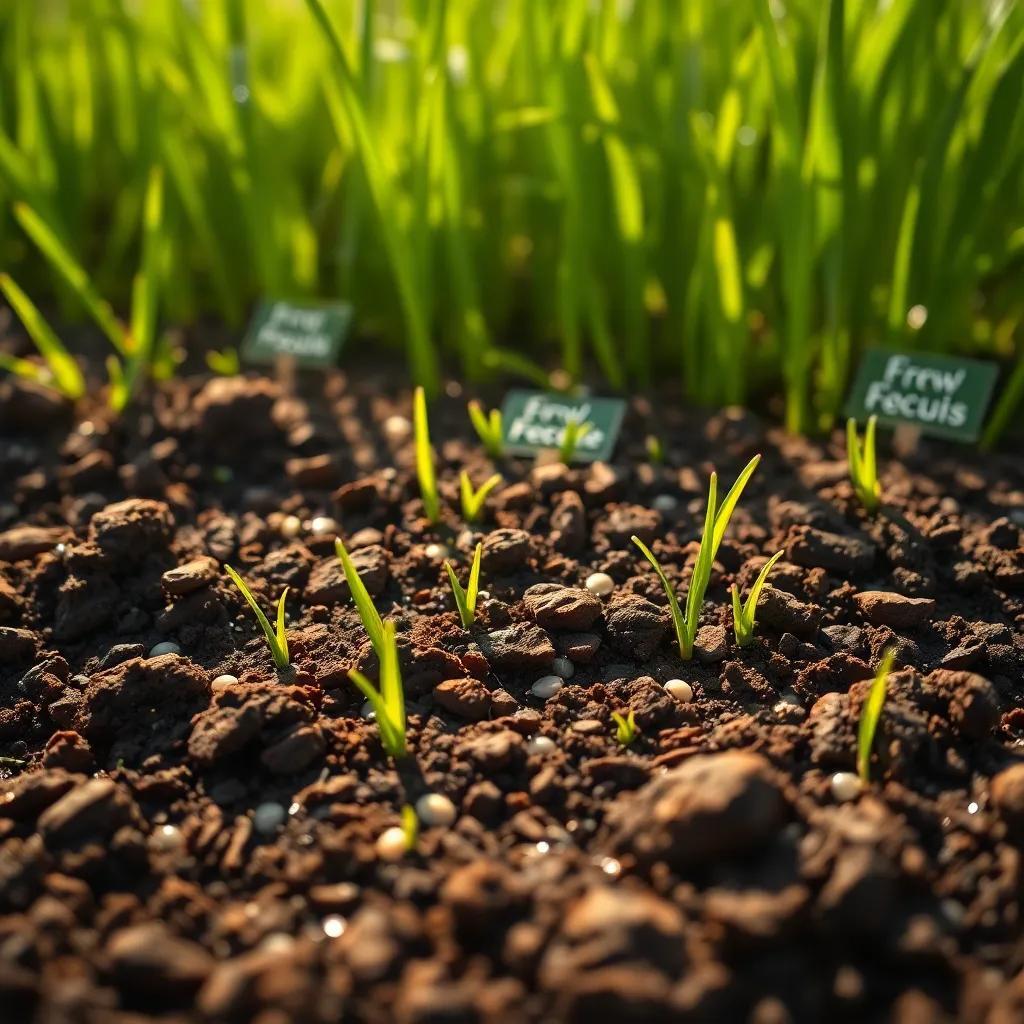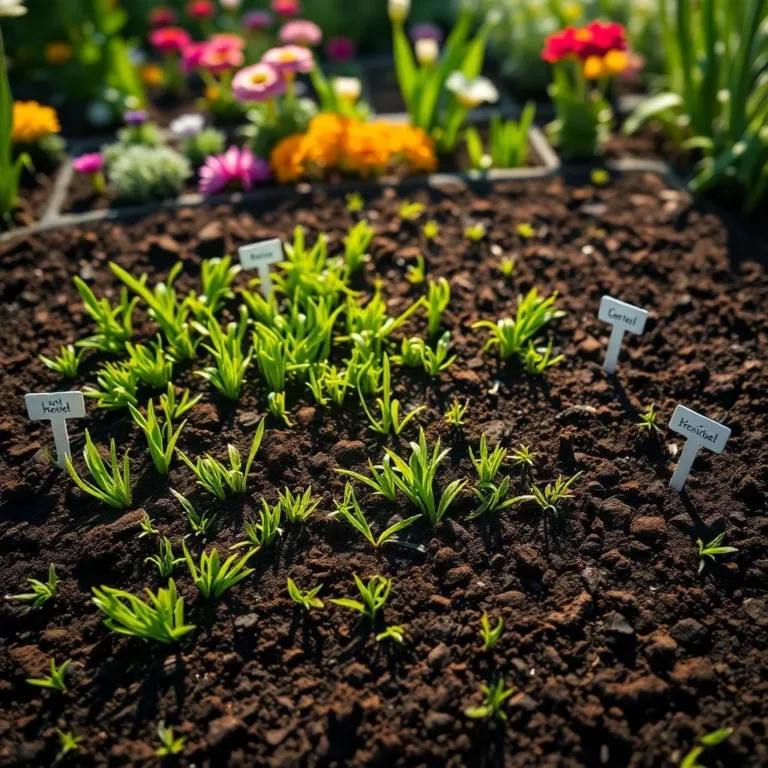Are you ready to transform your lawn into a stunning green oasis? Growing grass from seed can be an exciting adventure, but it’s not without its challenges! Join me as we explore the secrets to successful grass seed germination, care tips to nurture your lawn, and strategies to protect those delicate sprouts. Let’s get started on this journey to a beautiful yard!
Factors Influencing Grass Seed Germination Success
Hey there, grass enthusiasts! If you’re anything like me, you can’t wait to see that lush green lawn sprouting up after planting grass seed. But wait! Before we start dreaming of BBQs on the lawn, let’s talk about the factors that influence grass seed germination. Knowing these will help your grass grow strong and healthy!
- Soil Conditions: The quality of your soil is like the cozy blanket your grass seed needs to thrive! Make sure your soil is loose and well-draining. No one likes to get stuck in muck, right? Also, check the pH level—most grass seeds prefer a neutral pH between 6.0 and 7.0. If it’s too low or too high, adding lime or sulfur can help balance it out.
- Moisture Levels: Grass seeds need just the right amount of moisture. Think of it as a Goldilocks scenario—not too dry, not too wet! The soil should be consistently moist but not soggy. Watering lightly a few times a day is often best, giving seeds a chance to soak it up without being washed away.
- Temperature: Grass seeds are picky about temperatures! Different types of grass seeds have their favorites. For instance, cool-season grasses love temperatures between 60°F and 75°F, while warm-season grasses thrive when it’s between 80°F and 95°F. So keep an eye on that thermometer, folks!
- Light: Some grass seeds, like ryegrass, are sun worshippers! They need a good dose of sunlight to germinate properly. Others, such as fescue, can tolerate a bit of shade. Understanding your grass type will help you pick the best planting spot.
- Weed Competition: Weeds can be party crashers for your grass seeds! They compete for nutrients, water, and light. Clear out any unwanted guests before seeding to give your grass the best chance to establish itself.
By keeping these factors in mind, you can set your grass seeds up for success and enjoy a beautiful lawn in no time! Aren’t you excited to get started?
Common Grass Seed Types and Their Germination Timelines
Now that we know what helps grass seed thrive, let’s take a look at the different types of grass seeds and how long they take to germinate. It’s like knowing the cooking times for your favorite recipes!
Here’s a quick list of some common grass types and their germination timelines:
- Perennial Ryegrass: This one is the fastest germinator in the bunch! Expect it to sprout within 5 to 10 days. If you’re looking for quick results, perennial ryegrass is your go-to!
- Fescue Grass: Coming in at about 7 to 14 days, fescue grass is known for its durability. It’s a great all-rounder for various climates.
- Bermuda Grass: If you’re in a warmer area, Bermuda grass is right up your alley. It germinates within 7 to 10 days and loves the sun. Perfect for that sun-soaked backyard!
- Kentucky Bluegrass: A classic choice, but it’s the slowpoke of the group. It typically takes 14 to 21 days to germinate. Patience is key with this lush beauty!
- Zoysia Grass: A bit of a diva, Zoysia germinates in 14 to 21 days as well, but it really shines in warmer climates.
Understanding these timelines helps you plan your lawn project. Can you imagine seeing those tiny green sprouts peeking through the soil? It’s like waiting for bread to rise! Keep at it, and soon you’ll have a gorgeous lawn that you’ll be proud to show off. Happy planting!

Essential Care Tips for Newly Seeded Lawns
Alright, lawn lovers! Now that you’ve planted your grass seeds, it’s time to give them the TLC they need to grow strong and vibrant. Think of your newly seeded lawn like a little baby that needs specific care to thrive! Here are some essential care tips to help those seeds transition into a beautiful, green lawn.
- Watering: This is the big one! Your grass seeds need consistent moisture to germinate. Keep the soil lightly moist but not oversaturated. Watering early in the morning is ideal, allowing the grass to dry by evening. Aim for about 5 to 10 minutes of watering several times a day until the grass sprouts—just like giving it a gentle sprinkle!
- Fertilizing: When the seeds begin to show some growth, it’s time to feed them! Use a slow-release starter fertilizer, packed with nutrients like nitrogen, phosphorus, and potassium. These are crucial for healthy growth. Just be sure to follow the package instructions—too much fertilizer can be a bad thing!
- Mowing: Patience is key here! Wait until the grass reaches a height of 3 to 4 inches before mowing. Once it does, mow it down to about 2 to 3 inches. This not only helps promote stronger roots but also prevents weeds from taking over.
- Weed Control: Weeds are the sneaky adversaries of your lawn! Remove visible weeds by hand to give your grass the attention it needs. Be cautious with herbicides—wait until your grass is well established, or you might accidentally harm your new lawn.
- Traffic Control: Lastly, keep off the seeded areas! It’s tempting to walk on lush grass, but those delicate seedlings need all the space to grow without interruption. Consider placing markers to remind family and friends to stay clear!
With a little love and attention, your lawn will soon be the envy of the neighborhood!
When Is It Safe to Walk on Your New Grass?
Now, I know many of you are eager to get out there and enjoy your new lawn, but hold your horses! Walking on freshly planted grass too soon can lead to disaster—think of it as walking on a delicate cake before it’s done baking. So, when can you take that first step onto your green paradise? Let’s break it down!
- Germination Period: The first important phase is the germination period, which typically lasts around 7 to 21 days. During this time, it’s best to keep off the seeded area to let those little seeds do their magic!
- Visible Growth: Once you see the grass emerging, that’s a good sign! But don’t get too excited just yet. It’s recommended to wait until the grass is at least 3 to 4 inches tall before strutting your stuff on it. This usually takes a few weeks.
- Root Development: Remember, grass needs strong roots to stand up to foot traffic. Before stepping onto your grass, ensure its roots are well developed. If you can gently pull on a blade of grass and it stays put, you’re likely in good shape!
- Soil Conditions: The type of soil also matters! If your soil is still soft and easily compacted, it’s best to wait. You want to avoid damaging those tender roots.
- Environmental Factors: Check the conditions around you! Warm temperatures and adequate moisture help speed up growth, while cold and damp conditions might slow things down.
Patience is the name of the game! If you give your new grass the time it needs, you’ll be rewarded with a lush, green lawn that can stand up to some foot traffic before you know it!
Effective Strategies to Protect Newly Seeded Areas
Alright, fellow gardeners! You’ve put in the hard work planting your grass seeds, now it’s time to protect those precious little greens from harm. Here are some effective strategies to keep your newly seeded areas safe!
- Temporary Barriers: Consider creating temporary barriers around your seeded areas. You can use stakes and string to mark off sections, or even lightweight fencing. This serves as a visual cue to keep people and pets away—especially curious dogs who might think your lawn is their personal playground!
- Designated Pathways: If foot traffic is unavoidable, why not lay down some designated pathways? Use stepping stones, planks, or even old carpets to guide people around the freshly seeded areas. It’s like rolling out the red carpet for your grass!
- Keep Pets Away: We all love our furry friends, but pets can be a major threat to new grass. Consider using pet gates or fencing to keep them away until your grass is established. Think of it as a little vacation for them while your grass gets settled.
- Avoid Heavy Objects: If you have outdoor furniture or equipment, keep them off the newly seeded areas! The weight of these items can crush delicate seedlings, making them struggle to grow. Trust me, that patio set can wait!
- Monitor for Damage: Keep an eye on the newly seeded areas and check for any signs of damage. If you spot any areas where the grass has been disturbed, take action quickly to repair them. Reseed if necessary and give it a little extra care to encourage regrowth.
By following these strategies, you’ll give your new grass the best chance to thrive! Happy gardening, and may your lawn grow green and strong!

